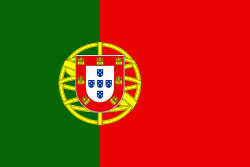Alcains
Alcains is a Portuguese civil parish in the municipality of Castelo Branco. The population in 2021 was 4615, in an area of 36.94 km². Alcains is located within the urban agglomeration of Castelo Branco - Covilhã - Guarda, situated 12 km to the north of Castelo Branco, 230 km to the northeast of Lisbon and 280 km southeast from Oporto, while 70 km to the west of the Portuguese-Spanish border and 380 km from Madrid). It is served by the A23_motorway_(Portugal) highway, by the EN18 and EN352 national roadways, and also a rail-line from Beira Baixa Linha_da_Beira_Baixa (Linha da Beira Baixa).
Remote history, indicated by diverse archaeological testaments, indicate a human presence in the area extending back to the pre-historic. During the Neolithic period there were implements discovered in the sites such as the Grulha and Lameira de Curia (today housed in the Museum Tavares Proença Júnior).
The Romanization of the area was also documented in the number of vestiges found in Cabeço da Pelada, such as a kiln and altar dedicated to the divinity Reve, from the 2nd century B.C. Remnants from two altars dedicated to an obscure Lusitanian sun goddess, Asidia were identified in 2008, during excavations in the Chapel of São Domingos, that also identify the Roman influence on the parish's history.
The toponymy Alcains is derived from the Arabic word for church and, according to some historians, may have had the same origin as Alcañiz, a city in the Spanish province of Teruel. In the 12th century the region belonged to the numerous villages and lands that comprised the Herdade de Açafa, dominion of Afonso Henriques. Much later, Afonso III donated these lands to the Knights Templar. Throughout the Middle Ages, its development was somewhat irregular, due to the constant demographic recessions of the region. By the end of the 14th century, the creation of the municipalities led to the survey and delimitation of the parish of Alcains.
Rich in historical and religious patrimony, the region was used by the nobility for summer homes and estates; the Viscounts of Oleiros (whom owned the Solares de Alcains) and the Viscounts of Idanha-a-Nova (who owned the Solares dos Goulões) were beneficial in developing the land in this region, and providing job opportunities. Several stories, legends and anecdotes surfaced during this period, identifying the daily humour and mythos of the community. By the early 16th century, Alcains began to recover economically, by taking advantage of its good geographic situation, through the creation of several workshops, and it later progressed due to the predominance of agricultural activities linked to creation major industries.
Owing to its urban growth, it was elevated to the category of vila (town) in 1971 by the decree No.495/71. Until the early 1990s, it was the most important industrial cluster in the municipality.
Remote history, indicated by diverse archaeological testaments, indicate a human presence in the area extending back to the pre-historic. During the Neolithic period there were implements discovered in the sites such as the Grulha and Lameira de Curia (today housed in the Museum Tavares Proença Júnior).
The Romanization of the area was also documented in the number of vestiges found in Cabeço da Pelada, such as a kiln and altar dedicated to the divinity Reve, from the 2nd century B.C. Remnants from two altars dedicated to an obscure Lusitanian sun goddess, Asidia were identified in 2008, during excavations in the Chapel of São Domingos, that also identify the Roman influence on the parish's history.
The toponymy Alcains is derived from the Arabic word for church and, according to some historians, may have had the same origin as Alcañiz, a city in the Spanish province of Teruel. In the 12th century the region belonged to the numerous villages and lands that comprised the Herdade de Açafa, dominion of Afonso Henriques. Much later, Afonso III donated these lands to the Knights Templar. Throughout the Middle Ages, its development was somewhat irregular, due to the constant demographic recessions of the region. By the end of the 14th century, the creation of the municipalities led to the survey and delimitation of the parish of Alcains.
Rich in historical and religious patrimony, the region was used by the nobility for summer homes and estates; the Viscounts of Oleiros (whom owned the Solares de Alcains) and the Viscounts of Idanha-a-Nova (who owned the Solares dos Goulões) were beneficial in developing the land in this region, and providing job opportunities. Several stories, legends and anecdotes surfaced during this period, identifying the daily humour and mythos of the community. By the early 16th century, Alcains began to recover economically, by taking advantage of its good geographic situation, through the creation of several workshops, and it later progressed due to the predominance of agricultural activities linked to creation major industries.
Owing to its urban growth, it was elevated to the category of vila (town) in 1971 by the decree No.495/71. Until the early 1990s, it was the most important industrial cluster in the municipality.
Map - Alcains
Map
Country - Portugal
 |
 |
| Flag of Portugal | |
One of the oldest countries in Europe, its territory has been continuously settled, invaded and fought over since prehistoric times. The territory was first inhabited by pre-Roman and Celtic peoples who had contact with Phoenicians, ancient Greeks and Carthaginians. It was later ruled by the Romans, followed by the invasions of Germanic peoples and the Islamic invasion by the Moors, whose rule was eventually expelled during the Reconquista. Founded first as a county of the Kingdom of León in 868, gained its independence as the Kingdom of Portugal with the Treaty of Zamora in 1143.
Currency / Language
| ISO | Currency | Symbol | Significant figures |
|---|---|---|---|
| EUR | Euro | € | 2 |
| ISO | Language |
|---|---|
| PT | Portuguese language |















